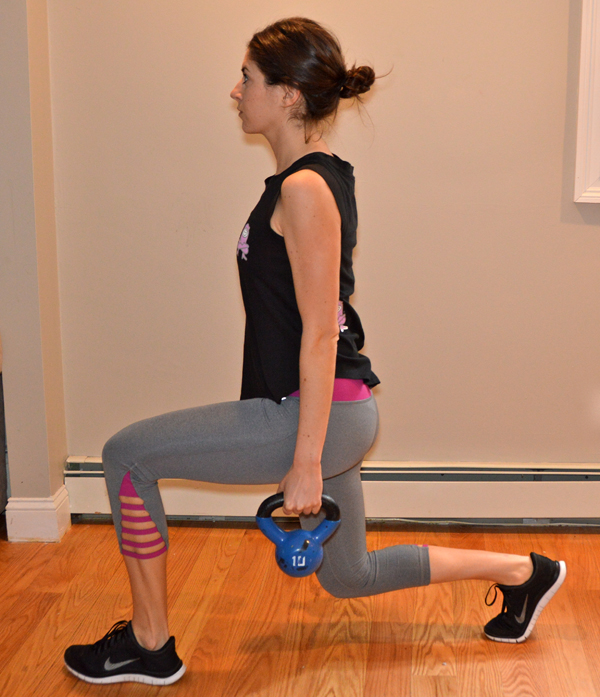
Lower body and back might seem like a weird muscle group combo to hit at the same time, but kettlebell exercises really all require core stabilization. Additionally, when you’re doing front weight-bearing moves (squatting holding a kettlebell at your chest or swings, for example), those back muscles are going to be engaged to keep you upright.
Lower-Body & Back Kettlebell Interval Workout
Equipment I Used:
- 25-lb kettlebell
- 20-lb kettlebell
- Two 10-lb kettlebells
Set an interval timer for 48 rounds of 30 seconds of work and 10 seconds of rest. You’ll go through the following circuit 4 times. In total, this workout will take you 32 minutes to complete. I’ve indicated the weight of kettlebell I used for each exercise, but adjust based on your fitness level.

- Kettlebell Swing Jumps: This is a regular kettlebell swing, except you’ll jump both feet up when the bell is at the top of your swing. You’ll start with knees slightly bent and butt back and swing the bell back through your legs. Using a hip thrust/powerful leg drive, swing the kettlebell up to just above eye-level and jump a couple inches off the ground. I started using a 20-lb bell and then switched to a 25-lb.
- Goblet Squats: Squat down, legs slightly more than shoulder-width apart, holding a kettlebell in both hands at your chest. Make sure you’re sending your hips back and not the knees forward and keep chest facing forward and upright. I used 25 lbs.
- Lateral Lunge Passes to the Left: Begin with kettlebell in your right hand and lunge out to the side onto your left leg, butt back. As you lunge out, gently swing the kettlebell around that left leg, passing it off to your right hand as you continue to circle it around that leg. Pass it back off to the right hand as you push off that left leg and return back to the starting position. I used a 20-lb bell.
- Lateral Lunge Passes to the Right
- Kettlebell Swing Jumps
- Figure 8s: Start with legs a bit more than shoulder-width apart and lower yourself into a shallow squat. Keep your back straight and chest up. You’ll hold the kettlebell in one hand and weave it around your legs in a figure 8 motion, passing it off between hands as you swing through the center. Each time through the circuit, reverse the direction in which you swing the figure 8. I used a 25-lb bell because it was the heaviest I had, but ideally I like to use a 35-lb bell for this exercise.
- One-Leg Deadlift (right): Holding a kettlebell in both hands, plant your right foot on the ground and keeping a straight leg and straight arms, bend forward with a flat back. Come as close as you can to toching the kettlebell to the ground by your right foot before slowly coming back upright. Your left leg stays straight as well, lifting up behind you. I used a 25-lb bell for the first two rounds but was having a really hard time balancing so I dropped down to a 20-lb bell.
- One-Leg Deadlift (left)
- Kettlebell Swing Jumps
- Tip-Toe Wall Sit: This is a normal wall sit, except you’ll be on the balls of your feet instead of having your foot flat on the ground. Knees should still be at 90 degrees, aligned with your ankles. Hold a kettlebell at your chest. I used a 25-lb bell.
- Forward/Backward Pivoting Lunge (right): Holding a kettlebell in each hand, lunge forward onto your left foot and then pushing off that front foot, come back upright and immediately step your left foot back into a lunge. Right foot stays planted on the ground in the same position as you lunge forward and backward, back and forth. I used two 10-lb bells.
- Forward/Backward Pivoting Lunge (left)

In today’s post I’m wearing a cap-sleeve top from Yogadude—I love the uneven hem higher on the sides, it’s such a flattering cut! They have a great selection of tanks, tees, sweatshirts and sleeveless hoodies (will definitely be wearing one of those on the blog this spring—they’re awesome). Check the line out here. I’m also slightly obsessed with the Yogadude Instagram…

Original article and pictures take pumpsandiron.com site
Комментариев нет:
Отправить комментарий